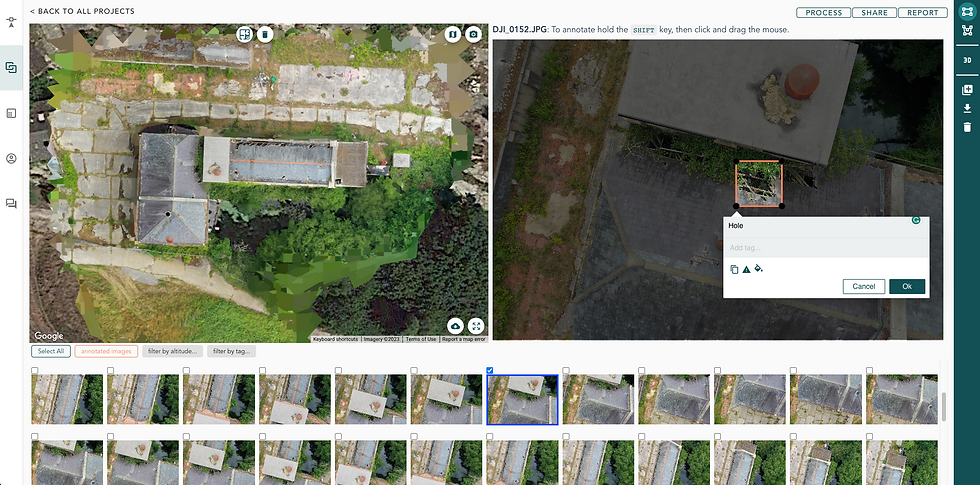Eye of the Storm: Using Drone Roof Inspections to Assess Weather Damage
- Hammer Missions

- Feb 13, 2024
- 4 min read
Updated: Mar 19, 2024
Our weather is getting worse. In 2023, a total of 7 storms were seen throughout the year in the UK, compared to 6 the previous year. With 3 named storms in a mere 6 weeks, it looks like we’re in for a bumpy ride in 2024. It’s no different in the United States. 2023’s hurricane season saw 20 storms ravage the US - the 4th highest number since 1950.
In the wake of a storm, the aftermath can be devastating, leaving homes and properties destroyed and the ‘lucky’ ones vulnerable to further damage. Traditionally, assessing roof damage post-storm has been a laborious and often risky task, involving manual inspections that consume time and resources. However, with the advent of cutting-edge technology, there's a revolutionary solution at the fingertips of insurance claims assessors and building maintenance teams – drone roof inspections.

Why Traditional Methods Fall Short
Historically, inspecting roofs for storm damage has involved climbing ladders, traversing slippery slopes, and manually examining every nook and cranny for signs of wear and tear. Not only is this approach time-consuming and physically demanding, but it also poses significant safety risks to inspectors.
Moreover, traditional methods might overlook subtle damages that could worsen over time, leading to costly repairs down the line. Manual roof inspections also take a lot of time. Not ideal when your property is vulnerable to the elements.

Enter the Game-Changer: Drone Roof Inspections
Imagine a fleet of drones soaring effortlessly over rooftops, capturing high-definition imagery and data with unparalleled precision. Drone roof inspections leverage advanced aerial technology to provide swift, accurate, and non-invasive assessments of storm damage.
Benefits of Drone Roof Inspections

1. Safety First
Drone roof inspections eliminate the need for manual inspections at height, keeping inspectors safely on the ground while drones navigate even the most challenging buildings. They also allow for close-up inspection of hazardous areas or areas which may be inaccessible to disaster crews and assessors.
Quite often, inclement weather conditions tend to last for a few days, rendering buildings unsafe and inaccessible until after the storm passes. Using a drone, you can access the site from a safe, and dry, distance.

2. Speed & Efficiency
Drone inspections speed up both the initial survey and the subsequent analysis of the roof survey data. Quick to use, a drone can carry out a roof inspection in less time than it would take a manual crew to conduct a risk assessment. Data can then be ported into your drone software and shared with internal and external teams at the click of a button, even while the roof inspection team is still on site to allow for rapid analysis and deployment of work crews.
Depending on the drone inspection software used, surveyors can also add annotations and tags to images to make it easier for those responsible to take action, saving time

3. Precision and Accuracy
Manual roof inspections throw up a whole host of challenges when it comes to precision. Surveying at height, especially when a building is damaged, can make it difficult to gather accurate images and measurements. Drone surveys can give detailed pictures and pinpoint the exact position and size of any damage quickly and easily. Thermal sensors can also be added for extra intelligence in emergency situations.

4. Cost-Effectiveness
Drone roof inspections cut costs dramatically. No scaffolding, no cherry-pickers (or even cranes in extreme situations) are required. Outside of storm damage, regular drone inspections can also help property owners and managers to keep an eye on their assets, giving early detection of potential issues and structural failures way before they escalate into major repairs, allowing for preventative maintenance to be carried out.
Drone roof inspections also cut down the cost of labour. Where it would have taken a few people to carry out a full manual inspection, it now just takes one drone operator to carry out the survey and deliver the report.
How Drone Roof Inspections Work
Drone roof inspections are surprisingly easy to carry out.
In simplified terms, this is how they work:

Preparation: A trained operator plans the flight path and ensures all safety protocols are followed and all critical areas of the building are covered.
Aerial Survey: The drone takes off and conducts a systematic scan of the roof, capturing detailed imagery as it goes along.

Data Analysis: Collected data is processed using specialist drone software, generating 3D models and comprehensive reports highlighting areas of concern.
Actionable Insights: Stakeholders receive detailed assessments and recommendations for repairs or maintenance, allowing repair crews to take action within hours of the drone inspection being carried out.

Want to know more about carrying out drone roof inspections? Take a look at this video:
Conclusion: Embracing Innovation for a Safer Future
In short, drones make roof inspection faster and more accurate while minimizing risks to both personnel and budgets.
Drone roof inspections represent a significant leap forward in the realm of storm damage assessment, offering a seamless blend of cutting-edge technology and practical utility. By harnessing the power of drones, property and business owners can safeguard their assets more effectively, ensuring swift action when it’s most needed as well as planning preventative maintenance to mitigate future issues.
In the calm before another inevitable storm, take a look at our guide to conducting roof inspections with drones:
About Hammer Missions
Hammer Missions provides survey-grade drone software solutions to help streamline drone inspections, site surveys, 3D mapping and asset monitoring projects.
Find out how Hammer Missions can simplify your next drone roof inspection.
Sign up for our free trial (no credit card required) or arrange a demo with one of our drone inspection specialists.



